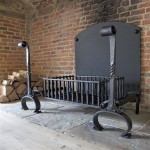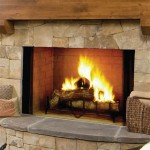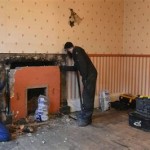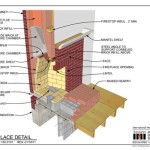Building A Brick Fireplace Outside: A Comprehensive Guide
An outdoor brick fireplace can transform a backyard into a welcoming gathering space, extending the usability of outdoor areas into cooler months. Beyond aesthetics, a well-constructed brick fireplace offers a durable and functional element for cooking, entertaining, and creating a relaxing ambiance. The process, however, requires careful planning, a solid understanding of masonry principles, and adherence to local building codes.
This article provides a comprehensive guide to constructing an outdoor brick fireplace, covering essential considerations from planning and design to the step-by-step construction process. It emphasizes the importance of safety, proper materials, and adherence to best practices to ensure a structurally sound and enduring fireplace.
Key Point 1: Planning and Design Considerations
The initial phase of building an outdoor brick fireplace centers on meticulous planning and design. This stage is critical as it establishes the foundation for a successful and safe structure. Before commencing any physical work, several factors must be thoroughly considered and addressed.
Location: The physical placement of the fireplace is paramount. It is necessary to adhere to local regulations regarding setbacks from property lines, structures, and flammable materials like trees and fences. Prevailing wind direction should also be taken into account to minimize smoke nuisance to neighbors and the users of the outdoor space. Furthermore, consider the proximity to seating areas and the overall flow of the backyard design.
Size and Design: The dimensions of the fireplace should be proportionate to the size of the outdoor space. A small backyard will be overwhelmed by a large fireplace, while a sprawling patio might require a more substantial structure to create a focal point. Consider the desired height, width, and depth of the firebox, as well as the dimensions of the chimney. Design choices should reflect the desired aesthetic, whether it be rustic, contemporary, or traditional. Sketches and scaled drawings are invaluable tools in visualizing the finished product and ensuring all elements are in harmony.
Building Codes and Permits: Prior to beginning any construction, it is mandatory to obtain the necessary building permits from the local authorities. These permits ensure that the fireplace design adheres to safety standards and local zoning regulations. Relevant codes often specify requirements for foundation depth, chimney height, firebox materials, and clearances from combustible materials. Failure to comply with these regulations can result in fines, mandated alterations, or even demolition of the structure. Contacting the local building department is the first step in understanding the specific requirements for the project.
Material Selection: The choice of materials significantly impacts the fireplace’s durability, appearance, and performance. Firebrick is essential for lining the firebox, as it can withstand the high temperatures generated by burning wood. Exterior bricks can be chosen for aesthetic appeal, but they must be suitable for outdoor use and resistant to freeze-thaw cycles. Mortar should be specifically formulated for masonry construction and appropriate for the climate. Other materials, such as concrete for the foundation and chimney liner for efficient smoke venting, are equally important.
Budget: Establishing a realistic budget is crucial for managing the project effectively. Material costs, permit fees, tool rentals, and potential labor expenses must be considered. It is prudent to obtain multiple quotes for materials and services to ensure competitive pricing. Unexpected expenses often arise during construction, so it is wise to allocate a contingency fund to cover unforeseen issues.
Key Point 2: Construction Process: Foundation to Chimney
The construction of an outdoor brick fireplace involves a series of sequential steps, each demanding precision and attention to detail. A solid foundation is the bedrock upon which the entire structure rests, followed by the careful construction of the firebox, smoke chamber, and chimney.
Foundation: The foundation must be deep and wide enough to support the weight of the fireplace and prevent settling. In colder climates, the foundation should extend below the frost line to prevent heaving due to freezing and thawing of the ground. A concrete footing is typically poured as the base of the foundation. Reinforcement with steel rebar is recommended to enhance the strength and stability of the concrete. Properly compacting the soil beneath the foundation is also crucial to prevent settling.
Firebox: The firebox is the heart of the fireplace, where the fire is contained. It must be constructed of firebrick, which is specifically designed to withstand extreme temperatures. The firebrick should be laid in a refractory mortar, which is also formulated for high-temperature applications. The shape and size of the firebox influence the draft and efficiency of the fireplace. A slightly angled back wall can help to radiate heat into the surrounding area. A hearth extension made of non-combustible material should extend beyond the firebox opening to protect the surrounding area from sparks and embers.
Smoke Chamber: The smoke chamber is the transition zone between the firebox and the chimney. Its primary function is to funnel smoke into the chimney. The smoke chamber should be constructed with smooth, angled walls to promote efficient smoke flow. Proper tapering of the smoke chamber is crucial to prevent turbulence and backdrafting. The damper, which controls the airflow through the chimney, is typically located within the smoke chamber.
Chimney: The chimney provides the necessary draft to draw smoke out of the firebox and into the atmosphere. The height of the chimney is critical for proper draft. Building codes typically specify minimum chimney heights based on roof pitch and proximity to other structures. A chimney liner, made of clay or metal, should be installed inside the chimney to protect the brickwork from corrosive flue gases. The chimney should extend above the highest point of the roof or any nearby obstructions to prevent downdrafts.
Mortar Joints: The mortar joints between the bricks are essential for the structural integrity and weather resistance of the fireplace. Consistent and even mortar joints are crucial for distributing weight evenly and preventing water infiltration. The mortar should be properly mixed to the correct consistency and allowed to cure fully before the fireplace is used. Tuckpointing, the process of repairing damaged or deteriorated mortar joints, should be performed periodically to maintain the integrity of the fireplace.
Key Point 3: Safety and Maintenance
Ensuring the safety of the outdoor brick fireplace is paramount, both during construction and throughout its lifespan. Proper maintenance is essential for preventing hazards and extending the fireplace's longevity.
Fire Safety: Clear a generous area around the fireplace of any flammable materials, such as dry leaves, branches, and outdoor furniture. Never leave a fire unattended. Keep a fire extinguisher or a water hose readily available in case of emergency. Ensure that the damper is fully open before starting a fire to prevent smoke from backing up into the firebox.
Structural Safety: Regularly inspect the fireplace for cracks, loose bricks, or deteriorated mortar joints. Address any issues promptly to prevent further damage and potential structural failure. Pay particular attention to the chimney, as it is exposed to the elements and prone to deterioration. If the chimney is leaning or showing signs of significant damage, consult a qualified mason for repair.
Chimney Cleaning: Creosote, a flammable byproduct of burning wood, can accumulate inside the chimney. Regular cleaning of the chimney is essential to prevent chimney fires. The frequency of cleaning depends on the type of wood burned and the frequency of use. A professional chimney sweep should be hired to inspect and clean the chimney annually.
Water Damage: Water infiltration can cause significant damage to brick and mortar. Ensure that the chimney has a rain cap to prevent water from entering the flue. Seal any cracks or gaps in the brickwork to prevent water from seeping in. Consider applying a water repellent sealant to the exterior of the fireplace to protect it from the elements.
Material Storage: Store firewood away from the fireplace and in a dry location. Keep flammable liquids, such as gasoline or kerosene, away from the fireplace at all times. Properly dispose of ashes in a metal container with a tight-fitting lid to prevent accidental fires.
Responsible Burning Practices: Burn only seasoned firewood, which has been properly dried for at least six months. Avoid burning treated wood, painted wood, or garbage, as these can release harmful toxins into the air. Do not overload the firebox, as this can create excessive heat and increase the risk of a chimney fire.

Outdoor Brick Fireplaces

Small Outdoor Brick Fireplaces Related Post From Diy Fireplace Plans

Outdoor Fireplace With Bench Seating W Tips From A Professional Mason

How To Make An Outdoor Brick Fireplace Firebrick For

How To Build An Outdoor Fireplace Today S Creative Life

How To Build A Brick Fireplace Diy Part 4 Of 5

Living Stone Masonry Stonetutorials

Red Brick Outdoor Fireplace Fireplaces Diy Plans

Diy Outdoor Fireplace Ideas

Living Stone Masonry Stonetutorials








